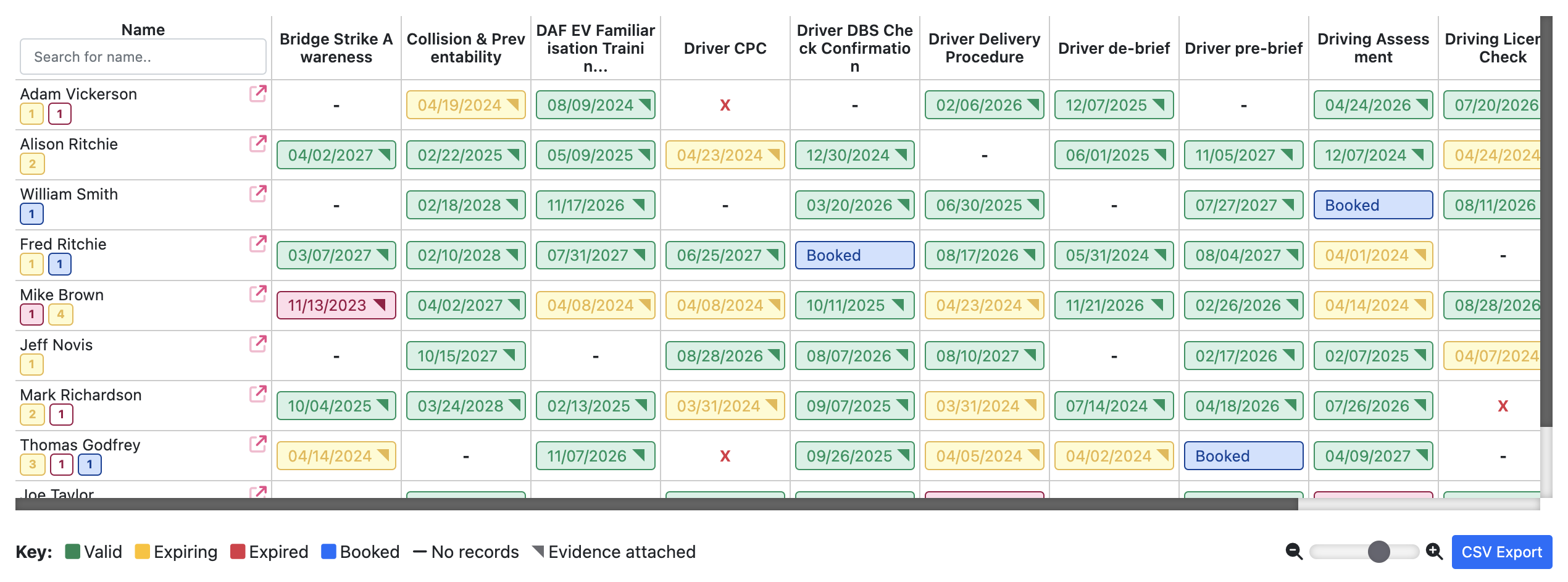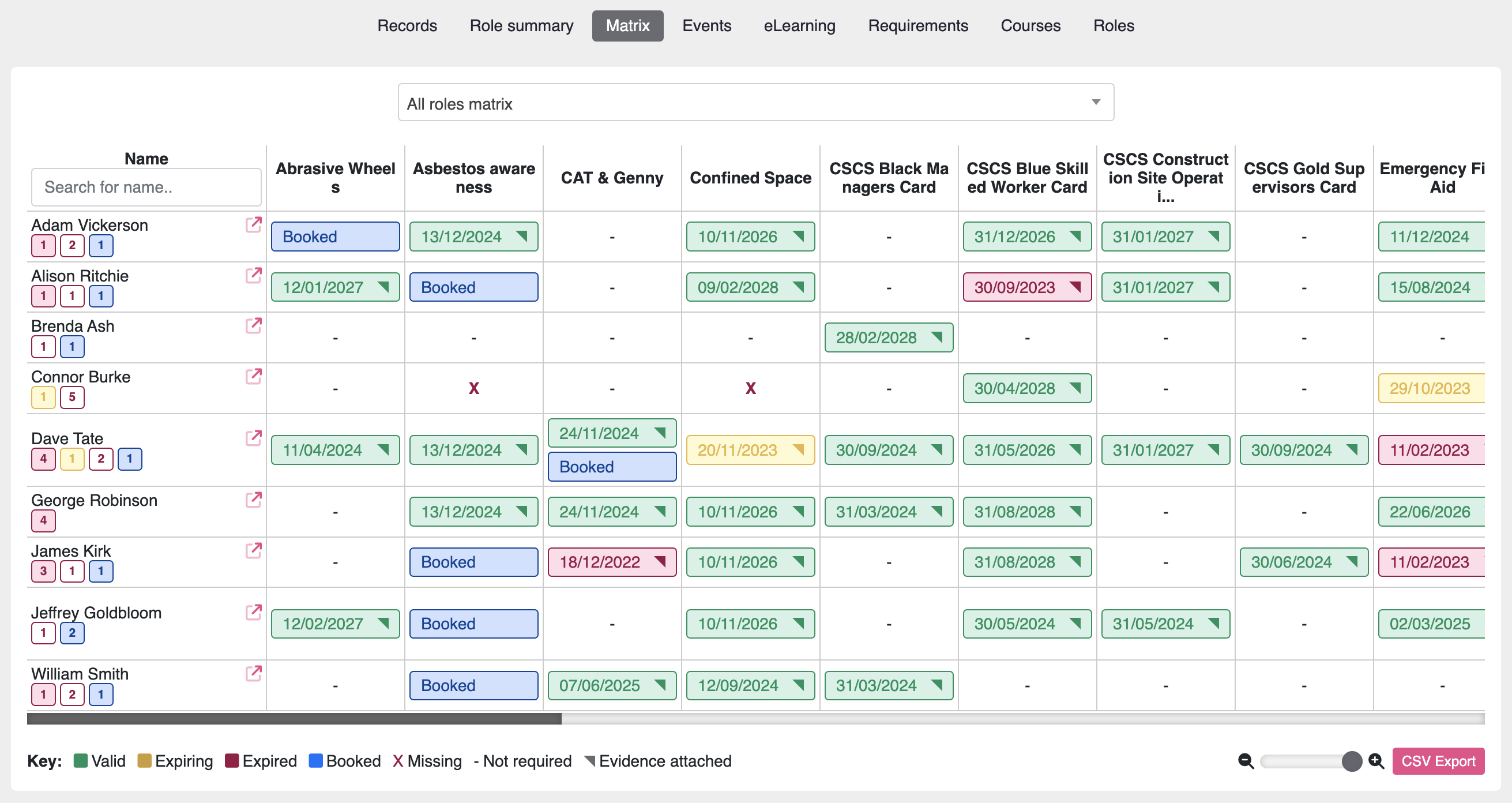A familiar Monday morning, until it isn’t
It is Monday morning. You arrive at the site, and the tools and team are in place; everyone is ready to work. The client is waiting. Suddenly, a message appears about expired certifications. A key team member’s expired certification poses a risk that brings everything to a standstill.
As a result, work grinds to a halt. Managers scramble, and spreadsheets are opened. On paper, everything looked fine, yet in reality, the project is delayed, costs are rising, and the client is losing trust.
Pause here for a moment.
Now, ask yourself: could this happen in your organisation?
This situation is not rare. In fact, over the years, talking to customers across regulated industries, we have heard the same story repeatedly. Organisations believed they were compliant, only to find that an expired certification had lapsed unnoticed.
Therefore, this blog explores why that happens, the hidden costs involved, how you can estimate your risk, and the steps that can prevent you from experiencing that Monday morning shock.
Table of Contents
- A familiar Monday morning, until it isn’t
- The spreadsheet illusion: when control feels safe but hides cracks
- The hidden costs of expired certification you will not see until they strike
- A pause for reflection
- Estimating your own risk of expired certificates
- Why spreadsheets fail over time
- What you need to fix the risk of expired certificates
- Transitioning without disruption
- Ready to overcome the risk of expired certification?
- FAQs
- References
The spreadsheet illusion: when control feels safe but hides cracks
Spreadsheets are often the first tool organisations use to track certifications because its seen as familiar, flexible, and inexpensive. However, that sense of control is misleading.
Research highlights the risk:
- A 2024 study reported that 94 percent of spreadsheets used in business decision making contain significant errors (Phys.org, 2024).3
- Operational spreadsheet studies show error rates in formulas of up to 1.8 percent (Powell, Lawson and Baker, 2008).
- In general business use, error rates of between 2 and 5 percent are common (Arxiv.org, 2008).
So, what do these errors mean in practice? They translate into wrong expiry dates, incomplete formulas, or simple copy and paste mistakes. In the context of training and compliance, this could mean that someone appears certified when they are not.
In addition, customers often describe the same pain points. A date is typed into the wrong cell, leading to renewals either too soon or too late. Conditional formatting built by one employee becomes unintelligible when that person leaves. Meanwhile, multiple spreadsheet versions circulate between teams, creating confusion. Thus, large sheets slow down, freeze, or corrupt. And historic records are overwritten, leaving nothing to show an auditor.
Over time, reliance on spreadsheets builds a fragile system. The cracks remain hidden until they cause serious consequences.
The hidden costs of expired certification you will not see until they strike
Expired certifications have a range of hidden costs. These are often invisible until an audit, an accident, or a project delay brings them to the surface.
- Time and productivity lost
Manual updates, reconciliation, and version management consume hours. When an expiry is discovered at the last minute, projects stop. As a result, refresher training taken too late becomes longer and removes staff from the site for extended periods. Duplicate training occurs when separate teams book without realising others have already acted. In addition, reporting on large sheets is slow, and locating records can take far too long. - Financial burden
Training costs rise when refresher courses become full courses. Meanwhile, managerial time is wasted on chasing, correcting, and reconciling data. Project delays lead to lost revenue. Moreover, remediation and audits cost additional money. Contract loss or disqualification can follow if certifications are not current.
UK fines demonstrate the wider cost of non-compliance. Employment-related violations between 2020 and 2024 alone cost businesses more than £272 million, with average fines around £12,600 (The HR Director, 2024). Safety and health compliance violations regularly account for a significant proportion of these costs. - Compliance, audit, and reputation
When certifications expire unnoticed, organisations often fail audits. Because without historic data, accreditation is at risk. Some contracts require continuous certification records. If you cannot demonstrate them, you risk losing business. A failed audit or an exposed lapse can quickly harm your reputation. - Safety and legal liability
At its core, the risk of expired certification threatens safety. Every person deserves to go home safe from work, and uncertified staff increases risk. In fact, in the UK, the Corporate Manslaughter and Corporate Homicide Act 2007allows prosecution of organisations where management failure leads to death (HSE, 2024). Recent cases have included fines of more than £700,000 for firms found guilty of corporate manslaughter (Clyde & Co, 2023).
Even where the act does not apply, health and safety prosecutions can result in fines, director disqualification, or prison sentences. Thus, the link between risk of expired certifications, unsafe work, and legal exposure cannot be ignored.

Figure 1: Shielding Against the Hidden Costs of Expired Certifications
👉 To explore how organisations assess real-world capability beyond the risk of expired certificates, you might find our guide on Competency-Based Assessment useful.
A pause for reflection
Consider your organisation for a moment.
How many certifications are currently being tracked? Also, check if you are managing them through spreadsheets, manual reminders, or fragmented systems? Have you ever faced a near miss, where a project was nearly delayed by an expired certificate? If an auditor asked for five years of complete certification records tomorrow, could you deliver them confidently?
If any of these questions cause hesitation, you are not alone. Many organisations do not realise their vulnerability until they are forced to.
Estimating your own risk of expired certificates
You can begin to estimate your hidden costs using a simple model.
| Metric | Definition | Example |
|---|---|---|
| Total certifications | The number of certificates you need to monitor | 1,000 |
| Average cost to train or renew | Direct cost per certificate | £500 |
| Lapse rate | Expected percentage of unnoticed expiries | 3 percent |
| Admin cost per lapse | Investigation and correction | £200 |
| Probability of major breach | Chance of a large fine or penalty | 0.5 percent |
| Penalty value | Size of fine or financial loss | £50,000 |
For example, here, 3 percent of 1,000 certifications is 30 lapses. At £700 per lapse, the direct cost is £21,000. Add the expected value of a major compliance breach at £250. Also, add reputational and contract risks, which can easily equal tens of thousands more. The total hidden cost is more than £41,000 annually.
This conservative estimate demonstrates why investment in automation pays off quickly.
Want to calculate this for your own organisation ? Download our FREE Calculator to access the risk of expired certificates.
👉 If you are interested in building a broader view of training records and spotting gaps early, take a look at our blog on ‘What is a Training Matrix?‘.
Why spreadsheets fail over time
However, spreadsheets are useful for small, temporary tasks. But,they are not designed for compliance. Problems accumulate as organisations scale and complexity grows.
Collaboration breaks down because multiple versions circulate with no single source of truth. Audit trails disappear as data is overwritten. Formulas and conditional logic deteriorate as they are changed. Large sheets slow down and crash. Updating formats and formulas requires constant maintenance. Above all, spreadsheets give a false sense of control. People trust what they see, but hidden errors undermine that trust.
What you need to fix the risk of expired certificates
Organisations that move beyond spreadsheets consistently report two major benefits: confidence and time. They achieve this with systems built specifically for compliance and certification management. Essential features include the following:
- Expiry and renewal alerts with automated workflows
- Complete audit logs and version histories
- Dashboards that show upcoming risks and training gaps in real time
- Secure role-based access and permissions
- Integration with HR, scheduling, and training systems
- Analytics and reporting tools that highlight trends and cost savings
- Secure backups that guarantee data integrity
These are exactly the challenges Moralbox was designed to solve. By replacing manual spreadsheets with a single source of truth, Moralbox gives organisations the assurance that nothing slips through the cracks. Customers tell us that instead of chasing dates and reconciling versions, they now focus on building skills, passing audits with confidence, and protecting both safety and reputation.
Transitioning without disruption
Change does not need to be disruptive. In fact, many organisations have successfully taken a phased approach. Begin with a baseline audit of certifications and data sources. Run a pilot group alongside existing spreadsheets. Clean and import your data. Configure alerts, permissions, and workflows. Train your users and highlight the time saved. Then expand to full roll-out and retire the spreadsheets.
This is where Moralbox makes a difference. Because it is intuitive and designed around real-world compliance workflows, adoption is straightforward. Teams quickly see the benefits: fewer errors, faster reporting, and real-time visibility. The result is a smooth transition that builds confidence rather than resistance.
Ready to overcome the risk of expired certification?
Many times, expired certifications risk may appear to be small oversights, but they carry hidden costs across time, money, compliance, safety, and reputation. They are not simply administrative mistakes. They are silent risks that grow until they cause project delays, fines, or worse.
If your organisation is still relying on spreadsheets, you are not alone. Many start there. But more and more are choosing to move beyond spreadsheets and embrace platforms designed for this exact challenge. Moralbox has been built with those needs in mind. By automating alerts, maintaining audit-ready records, and providing clear dashboards help organisations transform compliance from a daily worry into a source of confidence and growth.
Ask yourself: what is the hidden cost of expired certifications in your organisation, and how much peace of mind would you gain from knowing nothing is slipping through the cracks?
FAQs
What happens if employee certifications expire?
If an employee has expired certification, organisations risk compliance failures, project delays, safety incidents, and potential fines. Expired certificates can also result in failed audits and loss of accreditation or contracts.
Why are spreadsheets risky for managing certifications?
Spreadsheets are prone to human error, version control issues, and lack a of audit trails. Studies show that the majority of business spreadsheets contain errors, meaning even well-maintained files can miss expiry dates or overwrite historic data.
How can organisations prevent certifications from expiring unnoticed?
The most effective approach is to use a dedicated compliance management system. Tools like Moralbox provide automated alerts, dashboards, and audit-ready records, ensuring that training and certifications are always up to date without relying on manual spreadsheets.
References
Crockford, R. (2023) ‘Corporate manslaughter and gross negligence manslaughter sentencing’, Clyde & Co Insights, 20 September. Available at: https://www.clydeco.com/en/insights/2023/09/corporate-manslaughter-and-gross-negligence-mansla (Accessed: 30 September 2025).
Crown Prosecution Service (2018) Corporate manslaughter. Legal Guidance. Updated: 16 July 2018. Available at: https://www.cps.gov.uk/legal-guidance/corporate-manslaughter (Accessed: 30 September 2025).
Good Jobs First (2025) ‘Revealed: The corporate mistakes that cost UK businesses the most in fines’, Good Jobs First, 28 May. Available at: https://goodjobsfirst.org/revealed-the-corporate-mistakes-that-cost-uk-businesses-the-most-in-fines/ (Accessed: 30 September 2025).
Great Britain (2007) Corporate Manslaughter and Corporate Homicide Act 2007: Chapter 19. London: The Stationery Office. Available at: https://www.legislation.gov.uk/ukpga/2007/19/contents (Accessed: 30 September 2025).
Health and Safety Executive (2012) Health and safety training: A brief guide (INDG345). Available at: https://www.hse.gov.uk/pubns/indg345.htm (Accessed: 30 September 2025).
HSE: Corporate manslaughter (2019) Hse.gov.uk. Available at: https://www.hse.gov.uk/corpmanslaughter (Accessed: 30 September 2025).
Health and Safety Executive (2019) Training and competence – Work equipment and machinery, Hse.gov.uk. Available at: https://www.hse.gov.uk/work-equipment-machinery/training-competence.htm.
Panko, R.R. (2015) ‘What we don’t know about spreadsheet errors today: The facts, why we don’t believe them, and what we need to do’, in Proceedings of the EuSpRIG 2015 Conference: Spreadsheet Risk Management. Available at: https://arxiv.org/pdf/1602.02601 (Accessed: 30 September 2025).
Powell, S.G., Baker, K.R. and Lawson, B. (2008) ‘A critical review of the literature on spreadsheet errors’, Decision Support Systems, 46(1), pp. 128–138. https://doi.org/10.1016/j.dss.2008.06.001 (Accessed: 30 September 2025).
Powell, S.G., Lawson, B. and Baker, K.R. (2009) ‘Impact of errors in operational spreadsheets’, Decision Support Systems, 47, pp. 126–132. https://doi.org/10.1016/j.dss.2009.02.002 (Accessed: 30 September 2025).
Protecht (2025) ‘The most costly corporate mistakes in the UK’, Protecht Blog, 28 May. Available at: https://www.protechtgroup.com/en-gb/blog/the-most-costly-corporate-mistakes (Accessed: 30 September 2025).
Sentencing Council for England and Wales (2016) Corporate manslaughter: Definitive guideline. Effective from 1 February 2016. Available at: https://sentencingcouncil.org.uk/guidelines/corporate-manslaughter/ (Accessed: 30 September 2025).

Ananya is a Marketing Executive at Moralbox, passionate about creating content that connects learning with business impact.


